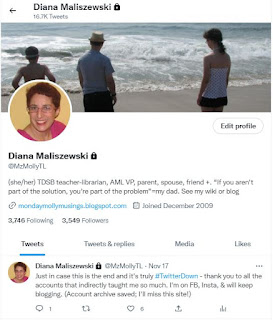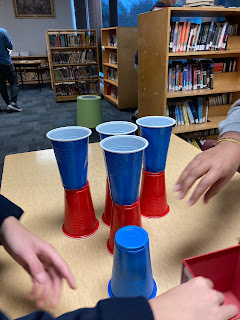Twitter is a dumpster fire.
For those of you who are non-users or only casual users, Twitter is under new "leadership".
Doug Peterson talked about it on his blog in October but it's gotten worse since that post. In the name of "free speech", certain individuals have had their Twitter accounts reinstated while others, like the above example, have had accounts suspended for insignificant reasons. Twitter was never a completely "safe" space, but it's noticeably declined. People I respect online and especially on Twitter provided these suggestions to prepare for the potential destruction and mass exodus:
- request an archive of your tweets
- lock your account
- change your password
- bookmark your archives
- delete your DMs
I've done almost all of these steps. (It's hard for me to delete the DMs because it can't be done in a batch and I like holding onto things.)
I haven't figured out a replacement yet. Doug Peterson shared his experience introducing himself to
Mastodon. Hive also looks promising. There are several articles championing various alternatives, like this one from
MakeUseOf or
PC Magazine, or
Paste. I already have Facebook, Instagram, WhatsApp, Signal, and Discord. Thing is, none of them are quite like Twitter.
I miss the community that was built over time on there. I miss the ability to share small snippets of my day in digestible bites that both friends and acquaintances could access. Here are a few moments that I would have tweeted this past couple of weeks.
My Loose Parts Update
I left the single, more impactful loose parts provocation and a few of the Grade 7s did some very cool things with the set-up.
As they explained to me, "we decided to create a mouth, because language is such an important part of culture".
A friend of theirs ago made this. I didn't get a chance to chat with him about what it represented, other than the most literal interpretation.
No one used the picture book as inspiration, so I think I'll have to actually teach how to interact with a loose parts provocation more explicitly, as Aviva suggested.
My next question for myself is, "How do I differentiate between the Makerspace materials and the Loose Parts equipment? Should I?" I think I will need to, because I don't want to keep buying new items that are meant for reuse. However, then I see a creation like this, made by a Grade 6 student who used a mix of loose parts and Makerspace resources to design a yo-yo.
STEAM Challenges for Intermediate Library Users
Another moment that would have been "Twitter share perfect" involved the Grade 6-8 classes. They have twenty-minute sessions once a week in the library as a whole class. The classroom teachers accompany them. The Grade 7 teacher noted that many of the students did not know how to use the unstructured time productively or appropriately. (Throwing puppets was a popular pastime for some individuals.) This gifted educator (Lisa Daley) gave me some ideas about how to maintain the welcoming, flexible environment while providing some constructive options and I ran with them. I created three STEM / STEAM challenges. I took two minutes to quickly explain them to classes and then gave them the rest of their half-period to do what they chose. Many of the students gravitated to the STEM challenges and really enjoyed them. Here are descriptions of the three and then some observations. Every activity had an element of student agency and science/engineering/math components.

Cup Pong with ping pong balls is a classic university/college party game that involves lots of predictions and attempts.
Buildzi is a game produced by the makers of Tenzi. As a fan of Tetris, I was drawn to the different shapes / solids (and this game is much cheaper than this
wooden Tetris game I was eyeing online).
This is a modified version of the game Tenzi. As described on the website
ilovetenzi.com,
"Everyone gets ten dice. Someone says, “Go.” Then everyone rolls and rolls as fast as they can until someone gets all their dice on the same number and shouts “TENZI.” Lots of different ways to play."
Once again, the students absolutely loved these games / centres. I love how they altered the rules and invented new ways of playing.
Sharing these via Twitter would have been more immediate and quicker than waiting for my weekly blog post.
Appreciation and Commiseration Posts
Tagging someone to thank them or share something wonderful they've done is part of what I like to do on Twitter. I have so many people I am thankful for. For instance, I am appreciative of our DECEs Jennifer Cadavez and Thess Isidro (plus volunteer Mayoori) for helping to facilitate the painting activity in the library. (I'll probably write more about it later, but take a quick peek at some of these photos.)
The same concept works with commiseration. I don't even have to go into detail. Just saying "Thanks Maha and Renee for Friday" or "Neil and Michelle, I'm glad I have you around" is sufficient. (It may be that months or years later, I won't have a clue what I was referencing. That's the case with looking at the yearbook comments from my then-best friend all written in shorthand. It's indecipherable to me now.)
ETT / ETFO Federation Day
Friday, December 2 was Federation Day, a professional learning day organized by our union. As much as I dislike learning exclusively in online spaces, sometimes it has its benefits. I attended the morning plenary sessions virtually and the experience was excellent. The lineup of speakers / presenters was just WOW - The Honourable Murray Sinclair, author Catherine Hernandez, Ricardo Tranjan ("numbers guy"), poet Shane Koyczan, politician Marit Stiles, Red Sky dancers and singer Shakura S'Aida. I took photos of some of my favourites. Shane made me weep with his powerful words. Catherine's connections had me smiling and several of my colleagues were asking to read my copy of her book.
Memes
Twitter used to be a great source of memes. Now, I have to rely on the family Discord server. This is, to use my son's words, a "home cooked meme" he created after helping his father.
It'll be interesting to see if I find my way to another social media site to scratch the itch that minimizing Twitter will invoke. I love Michelle's words to me in a conversation we had, that joining a new-to-me social media platform in 2022 will be different than the way I joined Twitter in 2009 because of the honed media lenses I wear based on past experience. Wait and see!



.jpg)












































